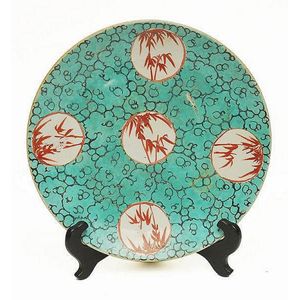Grisaille-decorated Chinese Charger, Guangxu Period
You must be a subscriber, and be logged in to view price and dealer details.
Subscribe Now to view actual auction price for this item
When you subscribe, you have the option of setting the currency in which to display prices to $Au, $US, $NZ or Stg.
- Grisaille - Decorative painting in monochrome, usually shades of grey, olive green or buff, painted on wood, plaster, ceramic or stone surfaces to imitate marble figural sculpture or relief ornament.Grisaille, from the French "gris", or grey (colour) is a painting technique in which a monochrome image is created using only shades of gray, black and white, usually created by using a gray underpainting or a limited colour palette. It is often used to create the illusion of sculpture or relief on a flat surface, and was commonly used during the Renaissance and Baroque periods.
The technique of grisaille has been used in decorative arts for centuries. It was commonly used in the Renaissance and Baroque periods in Europe to create the illusion of sculptural relief on flat surfaces such as walls, ceilings, and furniture. This technique allowed artists to create the illusion of depth and dimensionality without the use of colour.
During the Rococo period, grisaille was often used in the production of ceramics and porcelain to create finely detailed designs on a white or light-colored surface.
In the 19th century, grisaille continued to be used in decorative arts, particularly in the production of ceramics, both Western and Oriental. - Charger - A charger is a type of large plate, typically used as a decorative base for smaller plates or bowls. They are often used in formal settings, such as at a banquet or a special occasion.
The history of chargers can be traced back to medieval times, when they were used as a base for serving dishes in banquet settings. They were typically made of metal, such as silver or pewter, and were highly decorative, often featuring intricate engravings or designs.
During the Renaissance period, chargers began to be made of porcelain, and their designs became more ornate. They were often used in the homes of the wealthy and were considered a symbol of wealth and status.
In the 18th and 19th centuries, chargers were produced in great numbers by European porcelain manufacturers, and they were exported to America and other parts of the world. They were highly sought after by the upper class and were often used as a decorative element in formal table settings. - Qing Dynasty - The Qing Dynasty was the last imperial dynasty of China, ruling from 1644 to 1912. It was established by the Manchu people, who originated from the northeastern region of China. The Qing Dynasty was preceded by the Ming Dynasty and followed by the Republic of China.
- Ming Dynasty - The Ming Dynasty was a ruling dynasty of China from 1368 to 1644. It succeeded the Yuan Dynasty and preceded the Qing Dynasty. The Ming Dynasty was established by Zhu Yuanzhang, a former Buddhist monk who became a rebel leader and eventually overthrew the Mongol Yuan Dynasty. During the Ming Dynasty, China experienced a period of relative stability and prosperity. The government was centralized and bureaucratic, with the emperor at the top of the hierarchy. The Ming Dynasty is known for its cultural achievements, including the development of porcelain, the invention of movable type printing, and the construction of the Great Wall of China.
- Everted - An everted rim is an outwardly turning or flaring outwards rim, as seen the rims on jugs, vases, bowls and dishes.
This item has been included into following indexes:
Visually similar items

A Japanese Arita Shoki Imari plate, early 17th century, finely painted in underglaze blue with curved foot and broad shallow rim, diameter 28.5 cm diameter. Kintsugi gold repair to rim chip

A Chinese dish, 19th century decorated with bamboo cartouches on a turquoise ground, under glaze mark to base, apocryphal Qianlong mark, 24.5 cm diameter

A fine Nabashima three colour pedestal shallow dish, finely decorated with pomegranates to bowl and symbols of good fortune to underside of rim, 18 cm diameter

Crown Devon cabinet plate possibly 1960s an unusual hand painted plate featuring man and woman on lawn with umbrellas, stamped to base (crown Devon, Fieldings, made in England M350), diameter 30 cm
